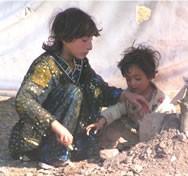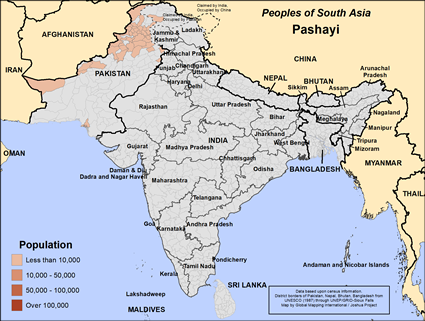Pashayi in Pakistan

Photo Source:
Anonymous
|

Map Source:
People Group data: Omid. Map geography: UNESCO / GMI. Map Design: Joshua Project
|
| People Name: | Pashayi |
| Country: | Pakistan |
| 10/40 Window: | Yes |
| Population: | 26,000 |
| World Population: | 79,000 |
| Primary Language: | Kohistani, Indus |
| Primary Religion: | Islam |
| Christian Adherents: | 0.00 % |
| Evangelicals: | 0.00 % |
| Scripture: | Portions |
| Ministry Resources: | No |
| Jesus Film: | Yes |
| Audio Recordings: | No |
| People Cluster: | South Asia Muslim - other |
| Affinity Bloc: | South Asian Peoples |
| Progress Level: |
|
Introduction / History
The British gained control of the Kohistani region around 1895 but left in 1947 when Pakistan became an independent nation. Yet, the Pushtuns have dominated the Kohistani for years, either buying their land or forcing them out with violence. Today, there are several ethnic groups living in the Kohistani region that are subgroups of the Kohistani people. They include the Pashayi, the Turvali, the Bateri, the Galo, the Rajkoti, and the Kohistani themselves. The tribes speak several distinct Dardic dialects, but their main language of communication is Pashto, the language of the dominant Pushtun ethnic group. Some of the Pashayis consider themselves to be Pashtun while others resent them. The Kohistani have been described as a powerful, well-built, brave, but quiet people. Though this is about the Pashayi tribe, what can be said about one Kohistani tribe also applies to the others. The Kohistani tribes live along the upper banks of the Swat and Panjkora Rivers in northern Pakistan, with a few in Afghanistan. They can also be found along the east bank of the Indus River and its tributaries, which run through the Kohistan district near the border of Afghanistan. This region of Pakistan contains some of the world's loftiest mountain peaks, deepest valleys and largest glaciers.
What Are Their Lives Like?
The Kohistani tribes, including the Pashayi, are located in the narrow valleys formed by the tributaries of the Indus. There is very little rain, so whenever possible, the crops are irrigated by water channels known as kuhls, which require constant and skillful management. Since the Indus River flows through a steep rocky gorge, irrigation is seldom possible, however. The people are primarily farmers and shepherds. They plant grain on terraced fields and use oxen for plowing. In the areas that are irrigated by the kuhls, the Kohistani raise barley, wheat, maize, millet, and rice, supplemented by potatoes and a variety of other vegetables. Since they can only grow one annual crop, the people rely on the "transhumant" herding of their dairy goats and cattle. This means that they transfer their livestock from one grazing ground to another with the changing of seasons. During the summer months, they leave their permanent villages and drive the cattle, goats and sheep to alpine pastures. The surrounding mountain ranges and the Afghanistan border tend to isolate the Kohistani. Most of their settlements exist as small independent communities, located at altitudes between 1,000 and 4,500 meters. Pashayi families usually have houses in four or five different locations at the higher altitudes. Only in the winter do they live together in their compact villages, which lie along the rivers. Pashayi villages are made up of several lineages. In addition to farmers, a village population normally includes blacksmiths and carpenters who are bilingual in Pashto. There are also a number of tenant farmers and hired farm laborers. The Pashayi generally practice endogamy, meaning that they only marry within their own groups. Their societies are also patrilineal, which means that the line of descent is traced through the males. The women are not secluded, as is customary among many Muslim groups, because they are needed to help with the farm work. The opening of the Karakoram Highway, which follows the Indus River Valley, has had the greatest economic impact on Kohistani subgroups, including the Pashayis. Although the extensive road-building project is providing them with greater access to the mainstream of Pakistani society, it is also encouraging the influx of Pushtun from farther south. There is a growing resentment among the Kohistani tribes toward the Pushtun, who dominate bureaucracy in the district government. However, the government of Pakistan has created the Kohistan district in order to give the Indus Kohistani their own administrative area.
What Are Their Beliefs?
Centuries ago, the area of northern Pakistan was primarily Buddhist. Later, Buddhism was replaced by Hinduism. However, around 1000 A.D., the Islamic faith spread through the region. At that time, the Kohistani converted from their polytheistic Aryan beliefs to Sunni (orthodox) Islam. Traces of traditional, pre-Islamic beliefs still linger in a few areas. Some of the tribes practice shamanism. They believe that there is an unseen world of gods, demons, fairies, and ancestral spirits. They depend on shamans (priests or priestesses) to cure the sick by magic, communicate with the gods, and control events.
What Are Their Needs?
The Islamic Republic of Pakistan, as its name denotes, does not promote freedom of religion. The country is mostly closed to Christianity and is opposed to the presence of missionaries there. Fervent intercession and further evangelistic efforts must be made in order to help turn the hearts of the Kohistani toward the Truth.
Prayer Points
Pray that the Lord will raise up tenacious and loving laborers who are willing to invest long term service to the Pashayis of Pakistan. Pray that Pakistani Christ followers will take steps to see the Pashayis and other peoples of the Kohistan region reached with the gospel. Pray that God will raise up linguists to translate the Word of God into each of the Kohistani languages. Ask God to send medical teams and humanitarian aid workers to minister to the Pashayis. Pray for a strong local networks of fellowships will be birthed within each of the Kohistani tribes.